Universally Grasping Objects with Granular—Tendon Finger: Principle and Design
Abstract
1. Introduction
Research Concept
2. Materials and Methods
2.1. Design of Granular-Tendon Robot Hand
2.2. Fabrication
3. Results
3.1. Finger Morphology
3.2. Finger Bearing Load
3.3. Grasping Performance
4. Discussion
5. Conclusions
6. Patents
Author Contributions
Funding
Institutional Review Board Statement
Informed Consent Statement
Data Availability Statement
Conflicts of Interest
References
- Shintake, J.; Cacucciolo, V.; Floreano, D.; Shea, H. Soft Robotic Grippers. Adv. Mater. 2018, 30, 1707035. [Google Scholar] [CrossRef]
- Goh, G.D.; Goh, G.L.; Lyu, Z.; Ariffin, M.Z.; Yeong, W.Y.; Lum, G.Z.; Campolo, D.; Han, B.S.; Wong, H.Y.A. 3D Printing of Robotic Soft Grippers: Toward Smart Actuation and Sensing. Adv. Mater. Technol. 2022, 7, 2101672. [Google Scholar] [CrossRef]
- Terrile, S.; Argüelles, M.; Barrientos, A. Comparison of Different Technologies for Soft Robotics Grippers. Sensors 2021, 21, 3253. [Google Scholar] [CrossRef]
- Zhang, Y.; Wan, X.; Xu, X.; Teng, P.; Wang, S. Recent progress of tree frog toe pads inspired wet adhesive materials. Biosurface Biotribology 2022, 8, 279–289. [Google Scholar] [CrossRef]
- Nguyen, P.V.; Ho, V.A. Grasping Interface With Wet Adhesion and Patterned Morphology: Case of Thin Shell. IEEE Robot. Autom. Lett. 2019, 4, 792–799. [Google Scholar] [CrossRef]
- Van Nguyen, P.; Luu, Q.K.; Takamura, Y.; Ho, V.A. Wet Adhesion of Micro-patterned Interfaces for Stable Grasping of Deformable Objects. In Proceedings of the 2020 IEEE/RSJ International Conference on Intelligent Robots and Systems (IROS), Las Vegas, NV, USA, 24 October–24 January 2021; pp. 9213–9219. [Google Scholar]
- Shin, J. Reversible Wrinkling Surfaces for Enhanced Grip on Wet/Dry Conditions. ACS Appl. Mater. Interfaces 2022, 14, 48311–48320. [Google Scholar] [CrossRef]
- Nguyen, P.V.; Huynh, N.V.; Phan, T.T.; Ho, V.A. Soft grasping with wet adhesion: Preliminary evaluation. In Proceedings of the 2018 IEEE International Conference on Soft Robotics (RoboSoft), Livorno, Italy, 24–28 April 2018; pp. 418–423. [Google Scholar]
- Nguyen, P.V.; Ho, V. Mechanics of wet adhesion in soft interaction with patterned morphology. Bioinspir. Biomim. 2018, 14, 016005. [Google Scholar] [CrossRef]
- Van Nguyen, P.; Ho, V.A. Wet Adhesion of Soft Curved Interfaces With Micro Pattern. IEEE Robot. Autom. Lett. 2021, 6, 4273–4280. [Google Scholar] [CrossRef]
- Hawkes, E.W. Grasping Without Squeezing: Design and Modeling of Shear-Activated Grippers. IEEE Trans. Robot. 2018, 34, 303–316. [Google Scholar] [CrossRef]
- Jung, H.S.; Choi, H.R. Shape-Adaptive Electrostatic Soft Gripper With Transform Mechanism for Multifunctional Grips. J. Mech. Robot. 2022, 15, 051015. [Google Scholar] [CrossRef]
- Li, Q.; Scarpa, F. Biobased and Programmable Electroadhesive Metasurfaces. ACS Appl. Mater. Interfaces 2022, 14, 47198–47208. [Google Scholar] [CrossRef]
- Gao, D.; Lee, P.S. A supramolecular gel-elastomer system for soft iontronic adhesives. Nat. Commun. 2023, 14, 1990. [Google Scholar] [CrossRef]
- Tian, H.; Li, X.; Shao, J.; Wang, C.; Wang, Y.; Tian, Y.; Liu, H. Gecko-Effect Inspired Soft Gripper with High and Switchable Adhesion for Rough Surfaces. Adv. Mater. Interfaces 2019, 6, 1900875. [Google Scholar] [CrossRef]
- Xu, K.; Zi, P.; Ding, X. Learning from biological attachment devices: Applications of bioinspired reversible adhesive methods in robotics. Front. Mech. Eng. 2022, 17, 43. [Google Scholar] [CrossRef]
- Hughes, J. Soft Manipulators and Grippers: A Review. Front. Robot. AI 2016, 3, 69. [Google Scholar] [CrossRef]
- Kim, Y.; Cha, Y. Soft Pneumatic Gripper With a Tendon-Driven Soft Origami Pump. Front. Bioeng. Biotechnol. 2020, 8, 461. [Google Scholar] [CrossRef]
- Phuong, H.L.; Thien, P.D.; Du, B.L. A Soft Pneumatic Finger with Different Patterned Profile. Int. J. Mech. Eng. Robot. Res. 2021, 10, 577–582. [Google Scholar]
- Jain, S.; Dontu, S.; Teoh, J.E.M.; Alvarado, P.V.Y. A Multimodal, Reconfigurable Workspace Soft Gripper for Advanced Grasping Tasks. Soft Robot. 2023, 10, 527–544. [Google Scholar] [CrossRef]
- Mazzolai, B.; Mondini, A.; Tramacere, F.; Riccomi, G.; Sadeghi, A.; Giordano, G.; Del Dottore, E.; Scaccia, M.; Zampato, M.; Carminati, S. Octopus-Inspired Soft Arm with Suction Cups for Enhanced Grasping Tasks in Confined Environments. Adv. Intell. Syst. 2019, 1, 1900041. [Google Scholar] [CrossRef]
- Kortman, V.G.; Sakes, A.; Endo, G.; Breedveld, P. A bio-inspired expandable soft suction gripper for minimal invasive surgery—An explorative design study. Bioinspir. Biomim. 2023, 18, 046004. [Google Scholar] [CrossRef]
- Calisti, M. An octopus-bioinspired solution to movement and manipulation for soft robots. Bioinspir. Biomim. 2011, 6, 036002. [Google Scholar] [CrossRef]
- Sui, D.; Zhu, Y.; Zhao, S.; Wang, T.; Agrawal, S.K.; Zhang, H.; Zhao, J. A Bioinspired Soft Swallowing Gripper for Universal Adaptable Grasping. Soft Robot. 2022, 9, 36–56. [Google Scholar] [CrossRef]
- Crooks, W. Fin Ray® Effect Inspired Soft Robotic Gripper: From the RoboSoft Grand Challenge toward Optimization. Front. Robot. AI 2016, 3, 70. [Google Scholar] [CrossRef]
- Fu, J.; Lin, H.; Prathyush, I.V.S.; Huang, X.; Zheng, L.; Gan, D. A Novel Discrete Variable Stiffness Gripper Based on the Fin Ray Effect. In Proceedings of the International Conference on Intelligent Robotics and Applications, Yantai, China, 22–25 October 2022; pp. 791–802. [Google Scholar]
- Yang, Y.; Jin, K.; Zhu, H.; Song, G.; Lu, H.; Kang, L. A 3D-Printed Fin Ray Effect Inspired Soft Robotic Gripper with Force Feedback. Micromachines 2021, 12, 1141. [Google Scholar] [CrossRef]
- 2F-85 and 2F-140 Grippers. Available online: https://robotiq.com/products/2f85-140-adaptive-robot-gripper (accessed on 8 May 2023).
- Cheng, P.; Jia, J.; Ye, Y.; Wu, C. Modeling of a Soft-Rigid Gripper Actuated by a Linear-Extension Soft Pneumatic Actuator. Sensors 2021, 21, 493. [Google Scholar] [CrossRef]
- Shao, G.; Sun, C. 3D printed magnetically-actuating micro-gripper operates in air and water. Addit. Manuf. 2021, 38, 101834. [Google Scholar] [CrossRef]
- Nie, K.; Wan, W.; Harada, K. A Hand Combining Two Simple Grippers to Pick Up and Arrange Objects for Assembly. IEEE Robot. Autom. Lett. 2019, 4, 958–965. [Google Scholar] [CrossRef]
- Marullo, S.; Bartoccini, S.; Salvietti, G.; Iqbal, M.Z.; Prattichizzo, D. The Mag-Gripper: A Soft-Rigid Gripper Augmented With an Electromagnet to Precisely Handle Clothes. IEEE Robot. Autom. Lett. 2020, 5, 6591–6598. [Google Scholar] [CrossRef]
- Kragten, G.A.; Herder, J.L. The ability of underactuated hands to grasp and hold objects. Mech. Mach. Theory 2010, 45, 408–425. [Google Scholar] [CrossRef]
- Nam, N.D.; Linh, H.N.; Thanh-Phong, D.; Ngoc, L.C. Multi-objective optimization design for a sand crab-inspired compliant microgripper. Microsyst. Technol. 2019, 25, 3991–4009. [Google Scholar]
- Sinatra, N.R. Ultragentle manipulation of delicate structures using a soft robotic gripper. Sci. Robot. 2019, 4, eaax5425. [Google Scholar] [CrossRef]
- Dao, T.; Nguyen, T.T. Analysis and optimization of a micro-displacement sensor for compliant microgripper. Microsyst. Technol. 2017, 23, 5375–5395. [Google Scholar] [CrossRef]
- Nguyen, P.V.; Le, T.L. Hybrid robot hand for stably manipulating one group objects. Arch. Mech. Eng. 2022, 69, 375–391. [Google Scholar]
- Makita, S.; Wan, W. A survey of robotic caging and its applications. Adv. Robot. 2017, 31, 1071–1085. [Google Scholar] [CrossRef]
- Tincani, V.; Catalano, M.G.; Farnioli, E.; Garabini, M.; Grioli, G.; Fantoni, G.; Bicchi, A. Velvet fingers: A dexterous gripper with active surfaces. In Proceedings of the 2012 IEEE/RSJ International Conference on Intelligent Robots and Systems, Vilamoura-Algarve, Portugal, 7–12 October 2012; pp. 1257–1263. [Google Scholar]
- Tran, N.T.; Dao, T.P. Optimal development for a 3D-printed gripper for biomedical and micromanipulation applications by non-parametric regression-based metaheuristic technique. Proc. Inst. Mech. Eng. Part J. Process. Mech. Eng. 2022, 446, 09544089221132446. [Google Scholar] [CrossRef]
- Van Nguyen, P.; Bui, T.H. Towards Safely Grasping Group Objects by Hybrid Robot Hand. In Proceedings of the 2021 4th International Conference on Robotics, Control and Automation Engineering (RCAE), Wuhan, China, 4–6 November 2021; pp. 389–393. [Google Scholar]
- Do, P.T.; Le, Q.N.; Luong, Q.V.; Kim, H.H.; Park, H.M.; Kim, Y.J. Tendon-Driven Gripper with Variable Stiffness Joint and Water-Cooled SMA Springs. Actuators 2023, 12, 160. [Google Scholar] [CrossRef]
- Li, L.; Xie, F.; Wang, T.; Wang, G.; Tian, Y.; Jin, T.; Zhang, Q. Stiffness-Tunable Soft Gripper with Soft-Rigid Hybrid Actuation for Versatile Manipulations. Soft Robot. 2022, 9, 1108–1119. [Google Scholar] [CrossRef]
- Mańkowski, T.; Tomczyński, J.; Walas, K.; Belter, D. PUT-Hand—Hybrid Industrial and Biomimetic Gripper for Elastic Object Manipulation. Electronics 2020, 9, 1147. [Google Scholar] [CrossRef]
- Su, Y.; Fang, Z.; Zhu, W.; Sun, X.; Zhu, Y.; Wang, H.; Tang, K.; Huang, H.; Liu, S.; Wang, Z. A High-Payload Proprioceptive Hybrid Robotic Gripper With Soft Origamic Actuators. IEEE Robot. Autom. Lett. 2020, 5, 3003–3010. [Google Scholar] [CrossRef]
- Nguyen, V.P.; Sunil Bohra, D.; Han, B.S.; Chow, W.T. Towards Flexible Manipulation with Wiring-Base Robot Hand. In Proceedings of the Robot Intelligence Technology and Applications, Barcelona, Spain, 26–28 October 2023; pp. 385–392. [Google Scholar]
- Nguyen, V.P.; Chow, W.T. Wiring-Claw Gripper for Soft-Stable Picking up Multiple Objects. IEEE Robot. Autom. Lett. 2023, 8, 3972–3979. [Google Scholar] [CrossRef]
- Brown, E.; Rodenberg, N.; Amend, J.; Mozeika, A.; Steltz, E.; Zakin, M.R.; Lipson, H.; Jaeger, H.M. Universal robotic gripper based on the jamming of granular material. Proc. Natl. Acad. Sci. USA 2010, 107, 18809–18814. [Google Scholar] [CrossRef]
- Yanjie, W.; Luo, M. Inflatable Particle-Jammed Robotic Gripper Based on Integration of Positive Pressure and Partial Filling. Soft Robot. 2022, 9, 309–323. [Google Scholar]
- Pushpakath, M.; Ang, M.H., Jr. Design of a Liquid Jamming Gripper. Designs 2023, 7, 44. [Google Scholar] [CrossRef]
- Götz, H.; Santarossa, A.; Sack, A.; Pöschel, T.; Müller, P. Soft particles reinforce robotic grippers: Robotic grippers based on granular jamming of soft particles. Granular Matter 2021, 24, 31. [Google Scholar] [CrossRef]
- Van Pho Nguyen, S.B.D.; Hoang, C.C.; Han, B.S.; Tan, J.Y.; Chow, W.T. Mitigate Inertia for Wrist and Forearm Towards Safe Interaction in 5-DOF Cable-Driven Robot Arm. In Proceedings of the 2023 IEEE/ASME International Conference on Advanced Intelligent Mechatronics (AIM), Seattle, WA, USA, 27 June–1 July 2023. [Google Scholar]
- Bressi, F.; Santacaterina, F.; Cricenti, L.; Campagnola, B.; Nasto, F.; Assenza, C.; Morelli, D.; Cordella, F.; Lapresa, M.; Zollo, L.; et al. Robotic-Assisted Hand Therapy with Gloreha Sinfonia for the Improvement of Hand Function after Pediatric Stroke: A Case Report. Appl. Sci. 2022, 12, 4206. [Google Scholar] [CrossRef]
- Li, M.; Zhuo, Y.; Chen, J.; He, B.; Xu, G.; Xie, J.; Zhao, X.; Yao, W. Design and performance characterization of a soft robot hand with fingertip haptic feedback for teleoperation. Adv. Robot. 2020, 34, 1491–1505. [Google Scholar] [CrossRef]
- Ding, L.; Deng, Z. Dynamic Finite Element Modeling and Simulation of Soft Robots. Chin. J. Mech. Eng. 2022, 35, 24. [Google Scholar] [CrossRef]
- Chow, W.T.; Graves, M. Stress analysis of a rectangular implant in laminated composites using 2-D and 3-D finite elements. In Proceedings of the 33rd Structures, Structural Dynamics and Materials Conference, Dallas, TX, USA, 13–15 April 1992. [Google Scholar]
- Nguyen, T.N.; Dang, L.M.; Lee, J.; Nguyen, P.V. Load-Carrying Capacity of Ultra-Thin Shells with and without CNTs Reinforcement. Mathematics 2022, 10, 1481. [Google Scholar] [CrossRef]
- Wang, C.; Liu, C.; Shang, F.; Niu, S.; Ke, L.; Zhang, N.; Ma, B.; Li, R.; Sun, X.; Zhang, S. Tactile sensing technology in bionic skin: A review. Biosens. Bioelectron. 2023, 220, 114882. [Google Scholar] [CrossRef]
- Van Nguyen, P.; Pham, V.C.; Tan, Y.; Ho, V.A. Toward a Tactile Ontology for Semantic Interoperability of the Tactile Internet. In Proceedings of the 2022 IEEE 16th International Conference on Semantic Computing (ICSC), Laguna Hills, CA, USA, 26–28 January 2022; pp. 115–118. [Google Scholar]
- Zhao, Z.; Tang, J.; Yuan, J.; Li, Y.; Dai, Y.; Yao, J.; Zhang, Q.; Ding, S.; Li, T.; Zhang, R.; et al. Large-Scale Integrated Flexible Tactile Sensor Array for Sensitive Smart Robotic Touch. ACS Nano 2022, 16, 16784–16795. [Google Scholar] [CrossRef]
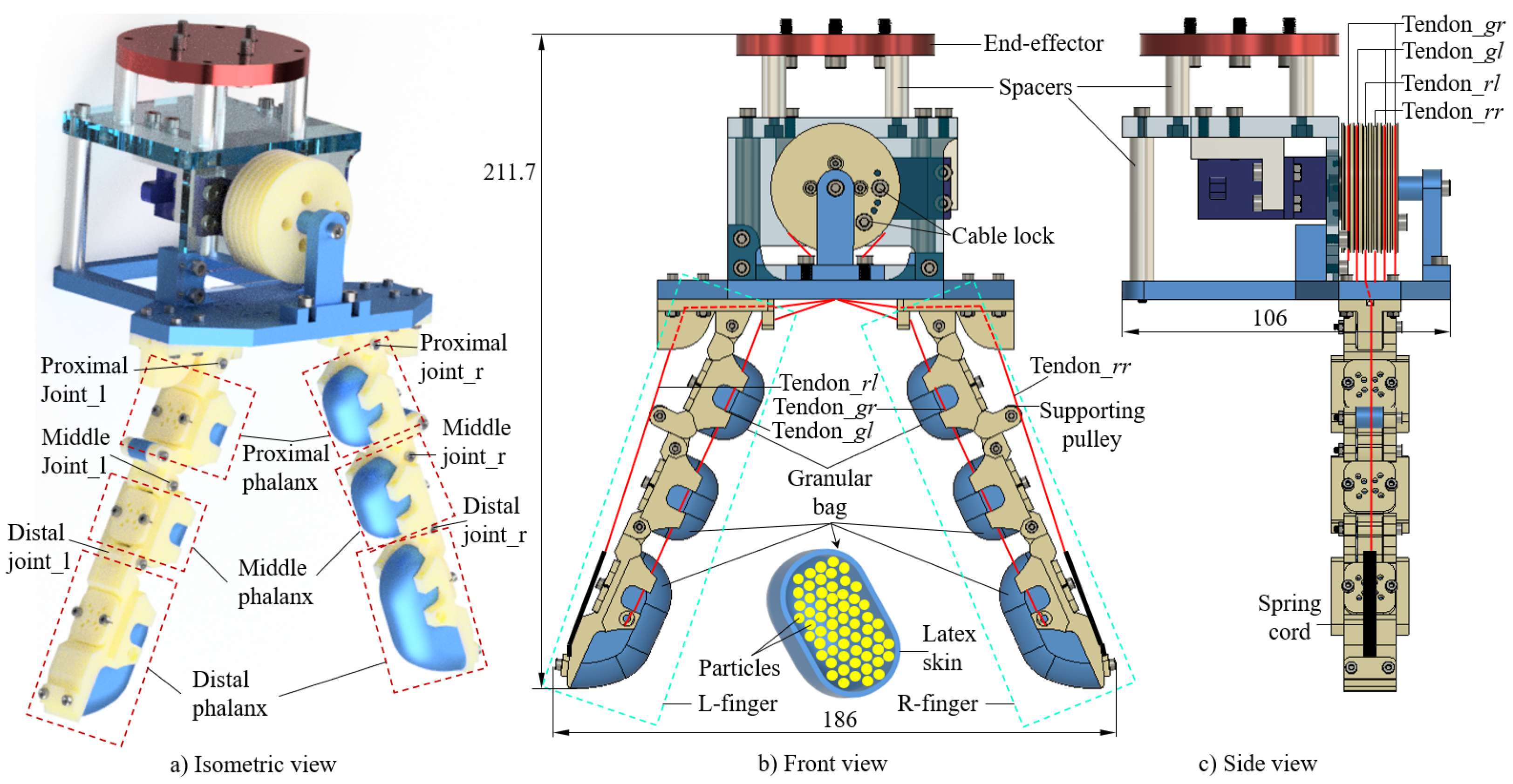
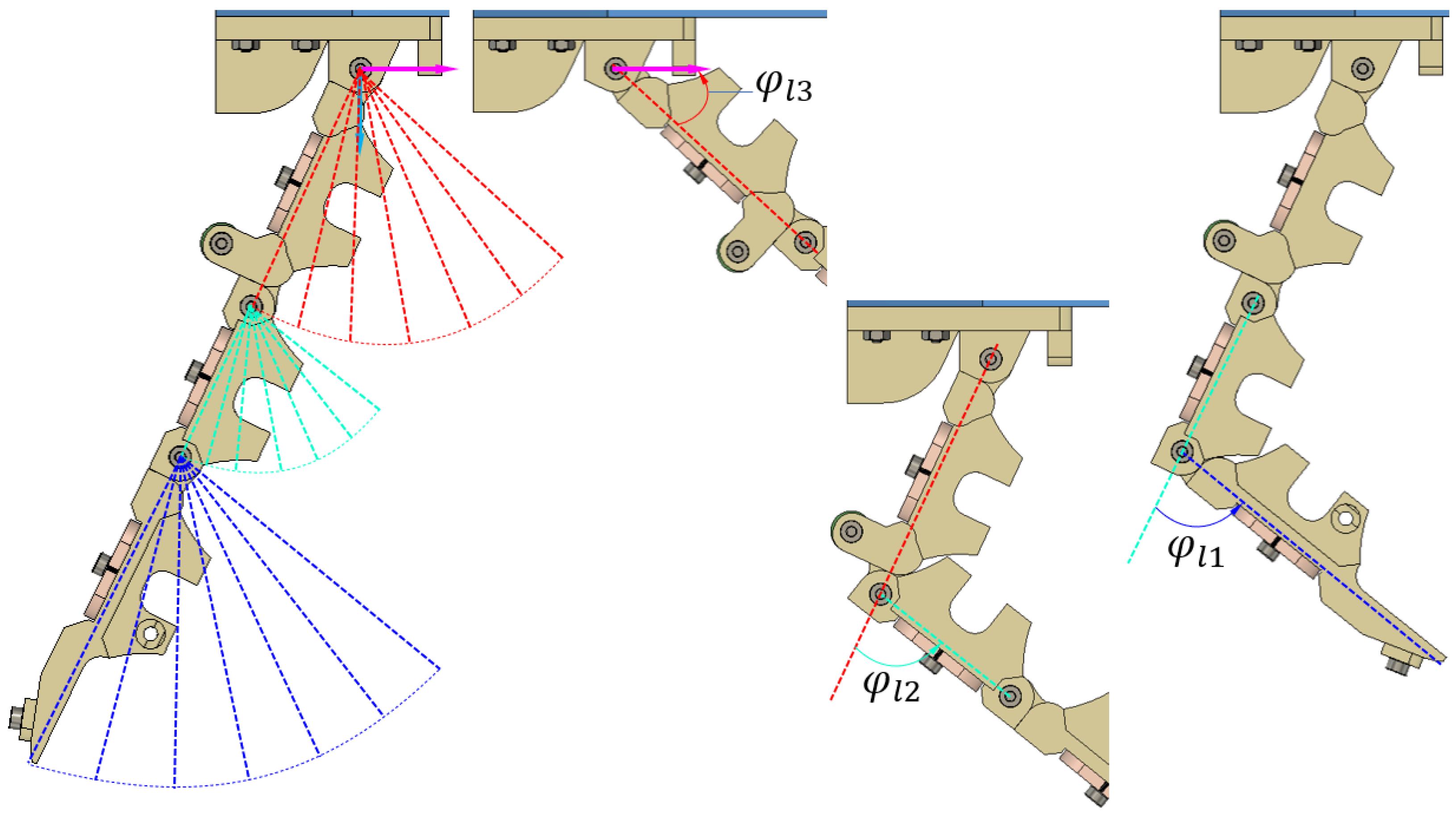

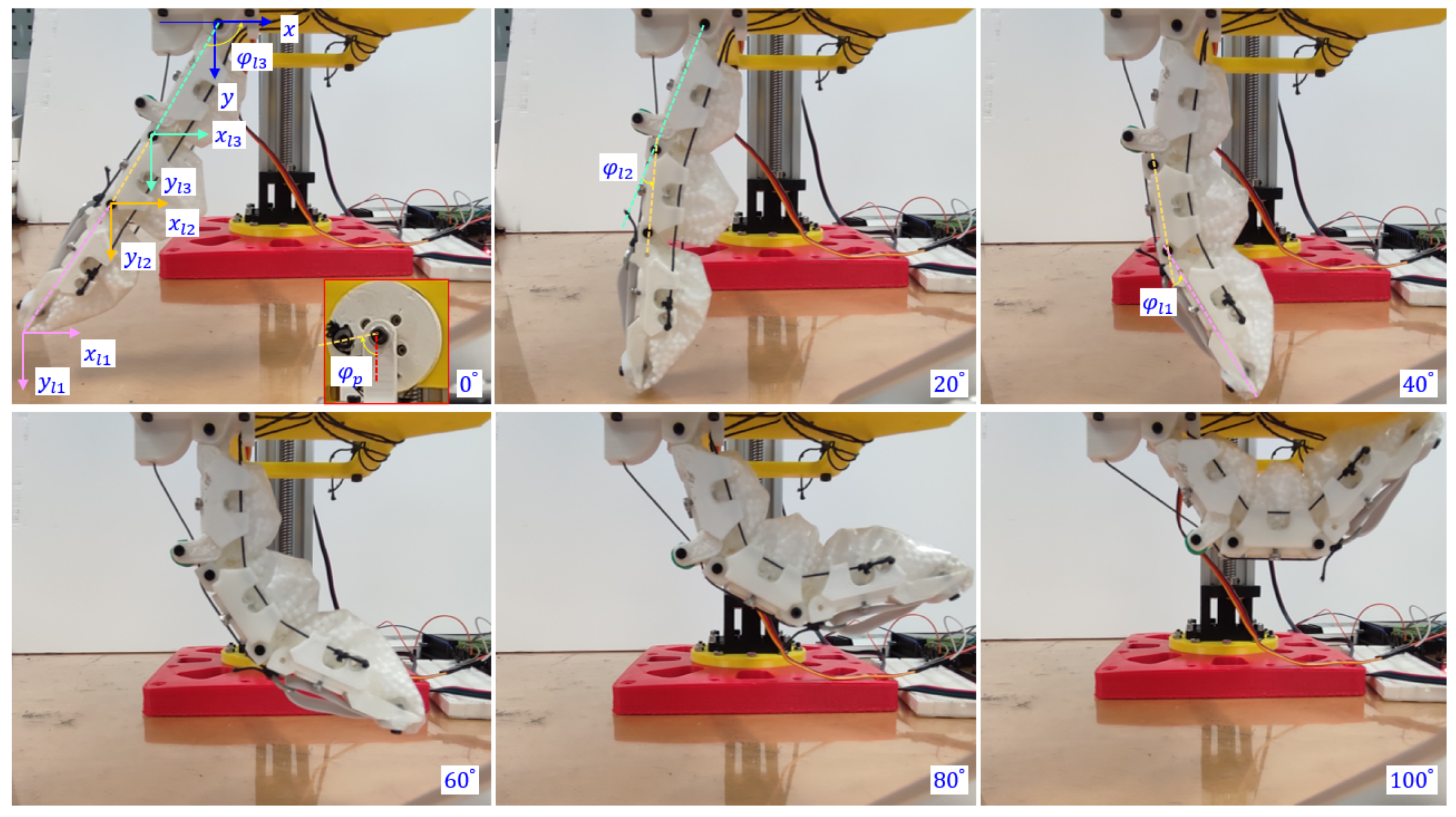
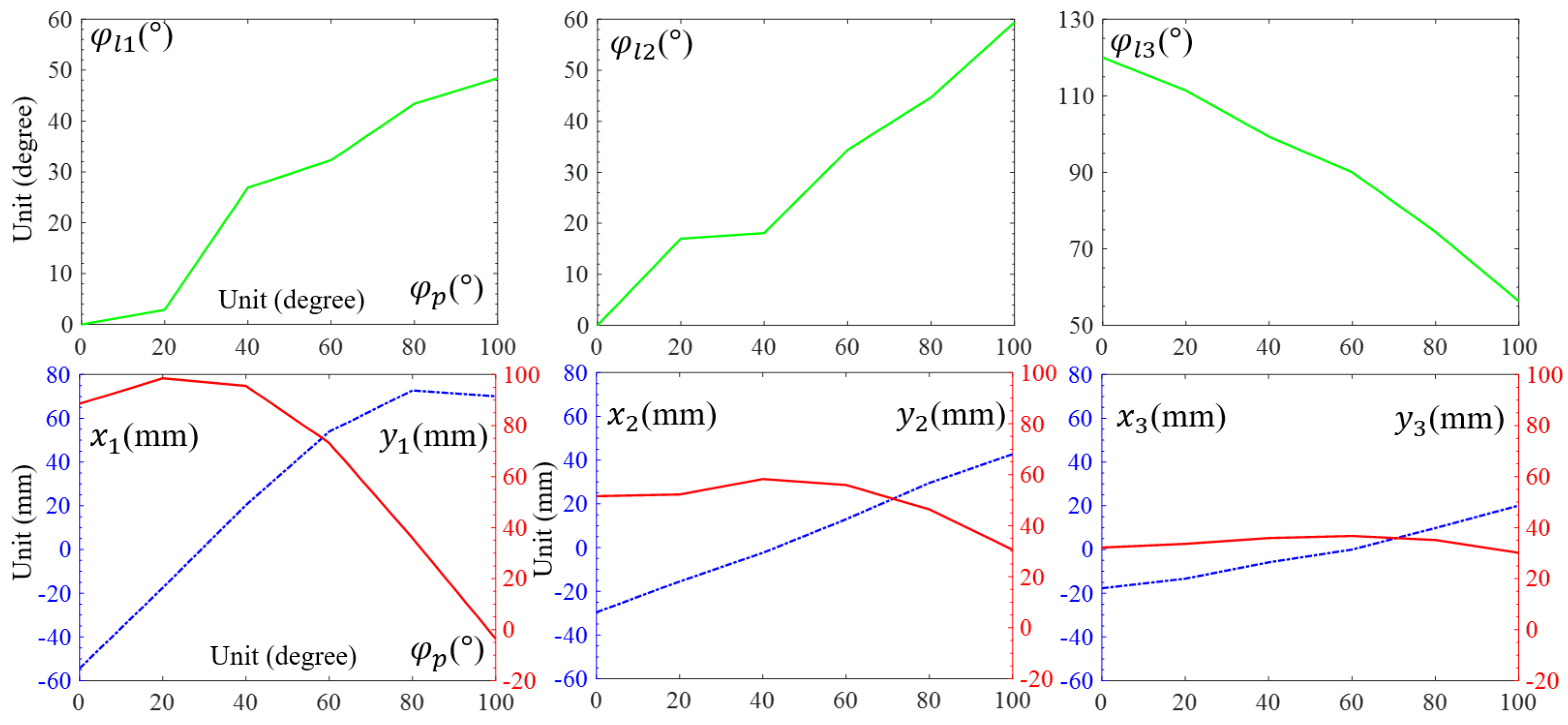


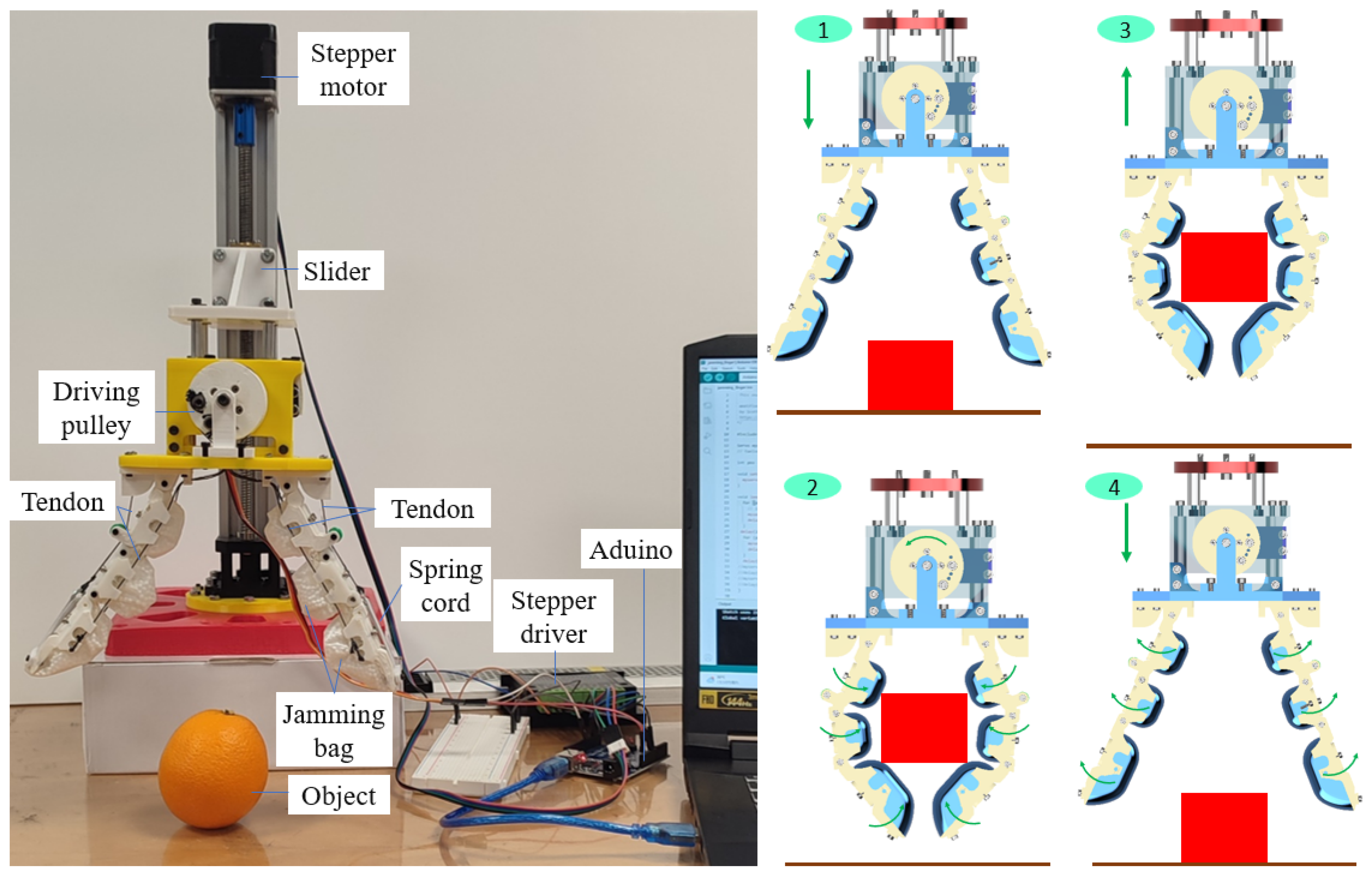
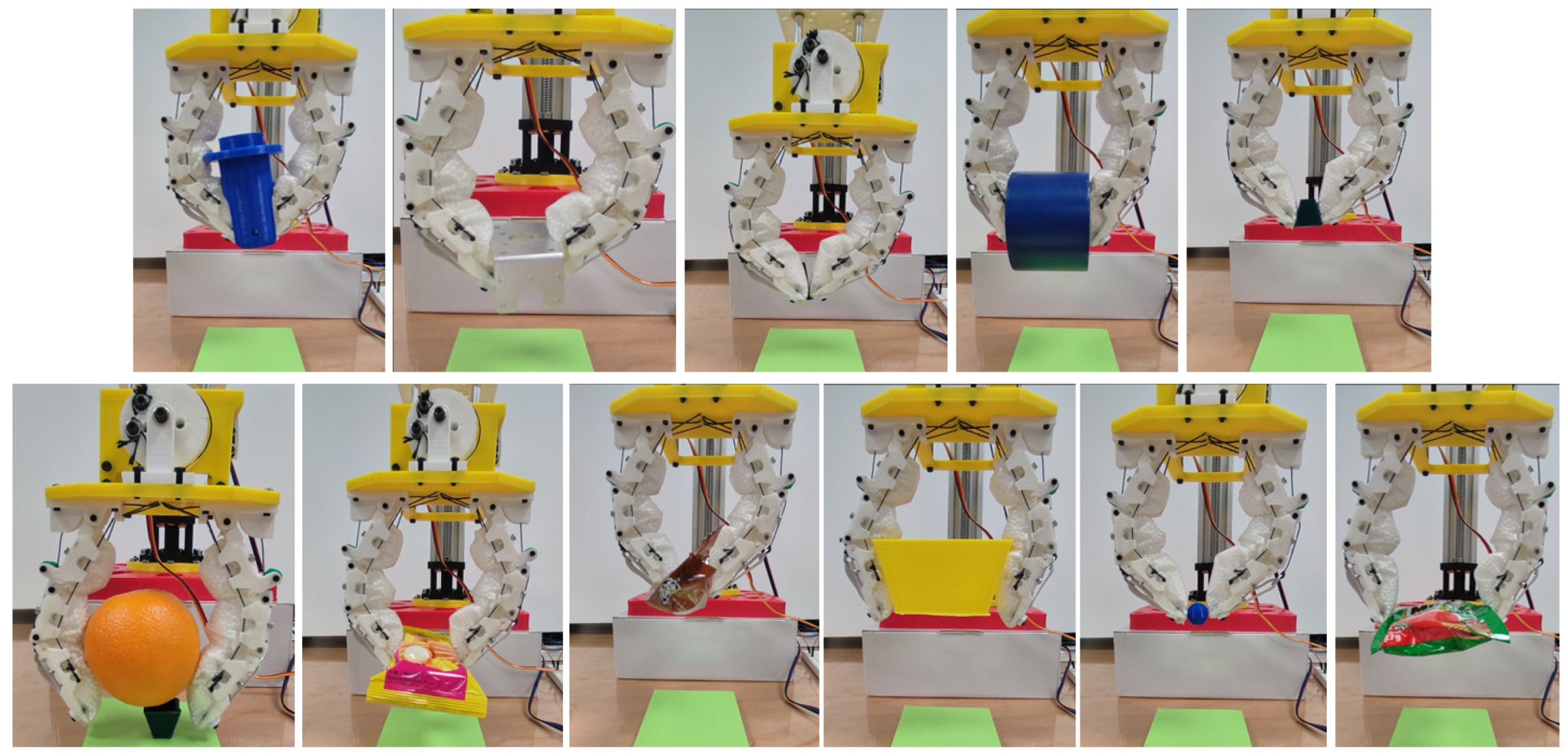

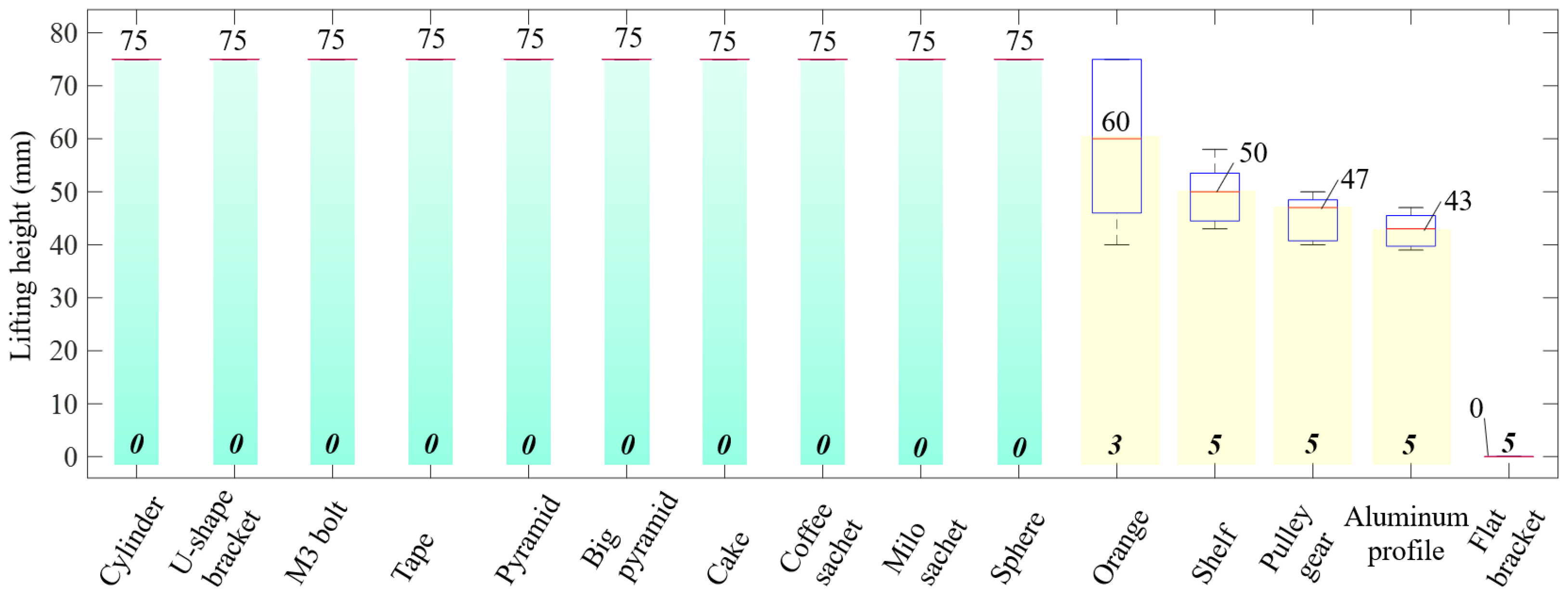
| Object | Weight (g) | Maximum Dimension (mm) | Properties |
|---|---|---|---|
| Cylinder | 23 | 72 | rigid |
| U-shape bracket | 13.3 | 66 | rigid |
| M3 bolt | 1.4 | 25 | rigid |
| Tape | 136.4 | 66 | rigid |
| Pyramid | 2.2 | 20 | rigid |
| Big pyramid | 20 | 85 | rigid |
| Orange | 210 | 55 | soft |
| Cake | 32.1 | 60 | soft |
| Coffee sachet | 31 | 180 | soft |
| Sphere | 1.5 | 15 | rigid |
| Drink sachet | 28.5 | 110.7 | soft |
| Shelf | 40 | 57 | rigid |
| Pulley gear | 30 | 65 | rigid |
| Aluminum profile | 64 | 30 | rigid |
| Flat bracket | 425.1 | 43 | rigid |
Disclaimer/Publisher’s Note: The statements, opinions and data contained in all publications are solely those of the individual author(s) and contributor(s) and not of MDPI and/or the editor(s). MDPI and/or the editor(s) disclaim responsibility for any injury to people or property resulting from any ideas, methods, instructions or products referred to in the content. |
© 2023 by the authors. Licensee MDPI, Basel, Switzerland. This article is an open access article distributed under the terms and conditions of the Creative Commons Attribution (CC BY) license (https://creativecommons.org/licenses/by/4.0/).
Share and Cite
Nguyen, V.P.; Dhyan, S.B.; Han, B.S.; Chow, W.T. Universally Grasping Objects with Granular—Tendon Finger: Principle and Design. Micromachines 2023, 14, 1471. https://doi.org/10.3390/mi14071471
Nguyen VP, Dhyan SB, Han BS, Chow WT. Universally Grasping Objects with Granular—Tendon Finger: Principle and Design. Micromachines. 2023; 14(7):1471. https://doi.org/10.3390/mi14071471
Chicago/Turabian StyleNguyen, Van Pho, Sunil Bohra Dhyan, Boon Siew Han, and Wai Tuck Chow. 2023. "Universally Grasping Objects with Granular—Tendon Finger: Principle and Design" Micromachines 14, no. 7: 1471. https://doi.org/10.3390/mi14071471
APA StyleNguyen, V. P., Dhyan, S. B., Han, B. S., & Chow, W. T. (2023). Universally Grasping Objects with Granular—Tendon Finger: Principle and Design. Micromachines, 14(7), 1471. https://doi.org/10.3390/mi14071471







